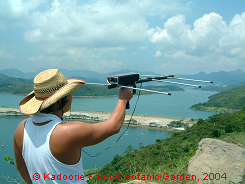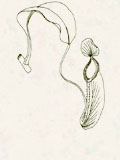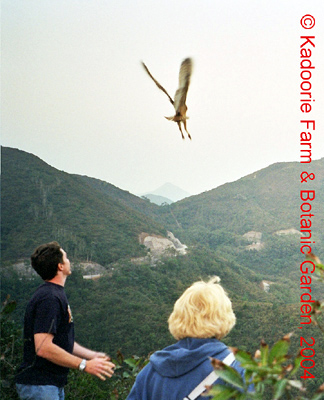
"From the Bar" (pdf)
Feature
essay: Wildlife rehabilitation and release at KFBG
by Rupert Griffiths
Introduction
KFBG Wild Animal Rescue Centre (WARC) carries out rehabilitation work for any native Hong Kong wildlife that is found injured or displaced. From 1994 to 2004, admittances of native animals to the centre totalled more than 2000*, and more than 1000 were released. Snakes make up the largest proportion of these animals (~50%) but birds follow closely behind (~40%).
The WARC also serves a second important function, that is as a holding and relocation facility for large numbers of confiscated endangered exotic species, but this article will focus only on the native wildlife rehabilitation side of the work.
Why do we undertake wildlife rehabilitation?
Some people who visit the WARC question the value of wildlife rehabilitation. Others blindly accept the need for it without proper consideration. We believe that there are two main reasons to carry out wildlife rehabilitation, animal welfare and species conservation, the former involves the element of compassion and the latter is scientifically based. Both have the long-term beneficial result of wildlife conservation and education but in different ways.
Some humans have this odd thing called 'compassion', and they feel the need to protect and help individuals that are less well off than themselves. This is where the role of the WARC starts. At KFBG we share this compassion and part of our mission is to help such stricken animals back to a normal life in the wild. It can be argued that such animals do not have what it takes to survive and this may be the case, but we are able to give them a second chance at survival in a world where the odds, already stacked against them, have been further increased by human development. By sharing compassion with the finder, we are actually helping them, and by illustrating our compassion to others, we hope to educate and pass on this compassion, resulting in a higher regard for the importance of wildlife, and eventually, greater protection and increased resource allocation for wildlife conservation work.
The number of a particular species being rehabilitated and released is usually very small in comparison to the number of individuals of that species in the wild, and they have little or no effect on the total population. Given suitable habitat, nature is far better at restocking population levels than people give it credit for. However, in some cases, the numbers of a species being rehabilitated is large in comparison to its wild population. This might happen when the number of admittances is very large, possibly due to a disaster such as an oil spill, or when the number of individuals in the wild is very small, such as species that are endemic to very small geographical regions. It is under such conditions that valuable species conservation work with immediate effect can be undertaken by wildlife rescue centres, and the years of experience and education gained through the rehabilitation of species of lower conservation value shows its true value to species conservation.
|
|
| Fig. 1. Bird release. |
Measuring the success of wildlife rehabilitation. Is the WARC successful?
After consideration of the purpose of the WARC as outlined above, we can see that KFBG needs to do two things for rescue work to be a success:
Ensure that our rehabilitation techniques and captive care follow high standards and are continuously improved;
Demonstrate genuine compassion for injured wildlife.
These two requirements are linked, as long as we fulfill the former requirement, and show the public that we have done so, the latter requirement is automatically fulfilled.
So does KFBG ensure the best possible rehabilitation practices? Well, this is a question of looking at measurable indicators and adherence to standards.
It can be argued that the admittance and release ratios for rescue centres, as well as data on expense and staffing levels can be used to determine the success of a centre. These black and white figures can be used to compare results with targets or with figures from other reputable wildlife rehabilitation centres. This might seem logical but different geographical regions and different habitats produce very different case-loads that, in most cases, are incomparable.
One of the main problems in determining successful wildlife rehabilitation is the inconsistency in standards between centres. Wildlife rehabilitation expertise is in short supply, especially in Asia, and there are few monitoring bodies or standards. In most cases the monitoring body for centres are the suppliers of the funds for the operation, and this leads to a tendency to exaggerate on the needs and successes of the centre, a dangerous situation in a profession that does most of its work behind closed doors. Although financial sustainability is a challenge for all wildlife rehabilitation centres, and therefore fund-raising is a high priority, it is important that wild animal rescue centres maintain their focus on the rehabilitation of the injured wildlife being admitted. The injured wildlife must remain the'client', not the finder or the fund-donator.
At the WARC we are fortunate that funding is currently not a problem. This allows us to keep the focus pure, and place full emphasis on the needs of the injured wildlife. We do the utmost to reach the highest of standards, keeping abreast of new techniques by reading relevant journals, attending international conferences and courses and by adapting our experience to new situations.
Proof of post-release survival is a much stronger indicator of success. Two forms of post-release monitoring that have been carried out at KFBG are radio-tracking and tagging.
Radio-tracking is a very good way of determining if a rehabilitation technique works and which methods are most successful. It can also be used as part of the rehabilitation process to provide post-release support. However, radio tracking is fairly time consuming and it is also difficult to determine a suitable target success rate, or length of study time. Many people would instinctively think that a survival rate for released birds below 30% to be very poor. However, numerous studies have shown a survival rate for wild birds as low as 30% in their first year of life and these birds are in their natural habitat and have the advantage of parental support. Suddenly a 30% survival rate for rescue centre releases is looking good. We presently have a survival and release of close to 60%. Post release monitoring is the only way to convert this release figure into meaningful survival data (Figs. 1 and 2).
 |
| Fig. 2. Radio-tracking monitoring after bird release. |
At KFBG we have reserved radio-tracking for special cases that may need post release support. Three large raptors have been tracked, 2 white-bellied sea eagles and 1 brown fish owl. It has been very encouraging for us that all 3 of these birds appeared to adapt to life in the wild and that all 3 were alive and well at the completion of their respective tracking studies.
Ringing and tagging is a less time consuming form of post-release monitoring. KFBG WARC uses clearly identifiable rings or tags on nearly all released birds. If released animals are found again, whether in good health or not, then information about that animal can be passed back to us and help us determine if our rehabilitation work is successful or not. The percentage of animals that are found after release is very low but every bit of information helps.
Of the approximately 400 birds released from the WARC between 1994 and 2004, we have received information concerning 4 as a result of rings. Amazingly, the information was positive in all 4 cases and even included photographic evidence of activities such as hunting and breeding.
The WARC could be considered a successful wild animal rescue centre based on the present rehabilitation and release successes, and the centre has managed to maintain a high level of expertise and innovation through experience, continued contact and collaboration with international rehabilitation organisations, and by maintaining the focus on reaching the highest standards of animal care. Our recently produced 60-page operational guidelines, that includes lengthy pre-release preparation techniques, is evidence of this.
* including local confiscations the total number of animals received is close to 10,000!
P.22-24
|
Porcupine! |
 Copyright © 2000 |

